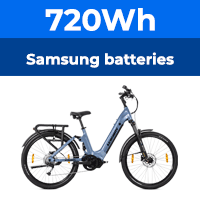Hi guys, I recently purchased a powacycle salisbury, it's a 24 volt 180 watt motor, the battery is good but the bike is a bit gutless, anything more than a very slight incline bleeds off the speed and power, I was wondering if there are options other than moving to Lincolnshire, I have recently gotten into pedelecs after a mild health issue so I am reliant on being able to get home regardless of any loss of power issues, thoughts guys.. Glyn
Options?
- Thread starter Gliggsy
- Start date
Not with out spending more money.
There is one mod you may be able to carry out but might stress the battery, you can try a controller shunt mod by adding a bit more solder to the shunt. The shunt is a current resistor and by adding more solder to it you can get more current from the controller. You need to tell us the controller current rating and the battery continuous discharge rating
There is one mod you may be able to carry out but might stress the battery, you can try a controller shunt mod by adding a bit more solder to the shunt. The shunt is a current resistor and by adding more solder to it you can get more current from the controller. You need to tell us the controller current rating and the battery continuous discharge rating
Are you sure the battery is good? An old battery can easily reach full charge voltage and give out a little current, but fall right away when you try to draw any more current (eg on hills).
OK guys some more info, managed to get out today and covered 20 miles or thereabouts but battery gave up on me very close to home, I have re-celled the pack with boston swing 5300 7s 2p and 13 amps discharge rate and 10.6 mah, I'm guessing everything is fine if its good for 20 mls but it's still gutless on any short inclines and I have to put the effort in to get the bike over the crest or get off and push (how degrading), I'm pretty sure the motor is cutting out because of the controller as it will come back to life once relieved of stress, would a new controller be a remedy do you think, I would hate to have to tackle a steep hill as I know neither of us would make it!
Attachments
-
3.6 MB Views: 8
-
3.5 MB Views: 8
20 miles is about right for that 24v battery
To get more power, you add a blob of solder to the shunt, which is that staple-shapped thing at the bottom of the photo. The idea is to solder up one side to the corner. The power increase is in direct relation to how much you solder. If you solder 25% of the complete length including the vertical bits, you get a 25% increase in power. 25% should be safe. 30% is the absolute limit, but I'd start with 10%, then see how you get on. A 25% increase will reduce your range to about 15 miles or less. The other potential problem is that if you go over what your battery can supply, it'll cut out. I'd be surprised if you have a battery that can't supply 20 amps, so it should easily be able to cope with a 25% increase.
Be careful that blobs of solder don't run down the leg and come out of the other side of the PCB. You need a hot soldering to do it, and a fair sized one like 60w - 100w
before

After

To get more power, you add a blob of solder to the shunt, which is that staple-shapped thing at the bottom of the photo. The idea is to solder up one side to the corner. The power increase is in direct relation to how much you solder. If you solder 25% of the complete length including the vertical bits, you get a 25% increase in power. 25% should be safe. 30% is the absolute limit, but I'd start with 10%, then see how you get on. A 25% increase will reduce your range to about 15 miles or less. The other potential problem is that if you go over what your battery can supply, it'll cut out. I'd be surprised if you have a battery that can't supply 20 amps, so it should easily be able to cope with a 25% increase.
Be careful that blobs of solder don't run down the leg and come out of the other side of the PCB. You need a hot soldering to do it, and a fair sized one like 60w - 100w
before

After

Last edited:
Maybe a little less than 25 say 20 % the problem I had was trying to get solder around the back side of the shunt as it was very close to a wire connection, with the state of my eyes I could have done with a loupe to give it a closer inspection, my shunt wasn't shaped so nice and square it was merely bent from one solder point to another and I can't be 100% that the solder reached the circuit board so I suppose that's the next relevant question. Should it?
It doesn't matter where you put the solder. You can put it in the middle if easier.
The shunt is a resistor, and it's resistance is in direct proportion to its length. Solder has almost no resistance, so the idea is to make some of the length of the shunt no resistance to reduce its overall resistance.
The controller CPU has a tap to each side of the shunt and is checking the voltage at each end. When current flows through a resistor, there is a voltage drop according to Ohms Law Voltage drop is equal to the current times the resistance or V=IR. It can see the voltage drop and thinks it knows the resistance (typically 0.005 ohms), so it calculates the current as I =V/0.005, but by soldering the shunt, you've changed the value of R to say 0.004 ohms, which means that you get the same voltage drop for 20% higher current. The CPU doesn't know that, so it still uses .005, miscalculates and allows a higher current.
To do the soldering accurately, you can use a wattmeter to measure the actual current. The wattmeter has its own shunt and works just like the CPU to calculate and display it. You just put the wattmeter or its shunt (if external shunt) between the battery and controller, lift the wheel off the ground and give full throttle or max pedal assist while slowing the wheel down to about 4 mph with the brake to get maximum current, which you can see displayed on the wattmeter. You can normally go as high as 18 amps without problems:

The shunt is a resistor, and it's resistance is in direct proportion to its length. Solder has almost no resistance, so the idea is to make some of the length of the shunt no resistance to reduce its overall resistance.
The controller CPU has a tap to each side of the shunt and is checking the voltage at each end. When current flows through a resistor, there is a voltage drop according to Ohms Law Voltage drop is equal to the current times the resistance or V=IR. It can see the voltage drop and thinks it knows the resistance (typically 0.005 ohms), so it calculates the current as I =V/0.005, but by soldering the shunt, you've changed the value of R to say 0.004 ohms, which means that you get the same voltage drop for 20% higher current. The CPU doesn't know that, so it still uses .005, miscalculates and allows a higher current.
To do the soldering accurately, you can use a wattmeter to measure the actual current. The wattmeter has its own shunt and works just like the CPU to calculate and display it. You just put the wattmeter or its shunt (if external shunt) between the battery and controller, lift the wheel off the ground and give full throttle or max pedal assist while slowing the wheel down to about 4 mph with the brake to get maximum current, which you can see displayed on the wattmeter. You can normally go as high as 18 amps without problems:

Power RC 130A Watt Meter Power Analyzer LCD Display High Precision CR | eBay
Find many great new & used options and get the best deals for Power RC 130A Watt Meter Power Analyzer LCD Display High Precision CR at the best online prices at eBay! Free delivery for many products!
www.ebay.co.uk
Last edited:
Related Articles
-
 MTF Enterprises announces acquisition of EMU Electric Bikes
MTF Enterprises announces acquisition of EMU Electric Bikes- Started by: Pedelecs
-
 Wisper 806T folding bike wins Which? ‘Best Buy’
Wisper 806T folding bike wins Which? ‘Best Buy’- Started by: Pedelecs
-
 Sustrans calls for protected cycle lanes
Sustrans calls for protected cycle lanes- Started by: Pedelecs
-
 Amazon launch their first UK e-cargo micromobility hub
Amazon launch their first UK e-cargo micromobility hub- Started by: Pedelecs





